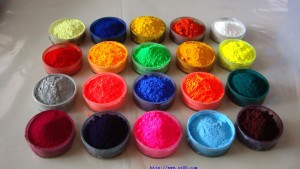
Dyes and pigments are the agents that are responsible for making our world so colorful today. In earlier times, dyes were sourced from plant and animal kingdom and even today some industries and applications still use such naturally sourced dyes. However, only a few of them have made it to the commercial markets.
Dyes can be defined as aromatic, colored and ionizing organic compounds which exhibit an affinity towards the substrate on which it is used. A mordant may be required to enhance the dye fastness on the substance on which it is used. According to application dyes can be categorized into basic dyes, reactive dyes, acid dyes, direct dyes, disperse dyes, vat dyes, napthol dyes and azoic dyes.
Reactive dyes are the latest in the list of dyes used over the years. They are increasingly used for a large number of applications. Besides being used for dyeing several fibers like silk, cotton and wool they are also suitable for polychromatic printing, screen printing, yarn dyeing and fabric painting. They have a higher color fastness quotient as compared to the conventional basic dyes. Their attribute of possessing washing and light fastness makes them a popular choice. Acid dyes are basic dyes that are acidified and are best suited for acrylics and nylon. They possess reasonably fair amount of light fastness but do not have strong wash fastness. Direct dyes on the other hand are noted for imparting bright colors to the substrate. This is possible as the cellulose fibers are colored in a hot dye-bath directly without the addition of a mordant. However, they have poor light and washing fastness. As against this, vat dyes have a high fastness quotient with regard to cellulose fibers. Synthetic indigo is one among the many popularly used vat dyes. The dyes that are best suited for synthetics are the disperse dyes. They impart strong and vibrant colors and have great wash and light fastness. But their application is limited to only synthetic fabrics. Basic dyes also impart bright colors but they have poor wash and light fastness though the fastness can be enhanced by giving an after-treatment.They occupy a place of importance in the textile industry with regard to dyeing of acrylic fibers. A mention has to be made of solvent dyes, a type of synthetic dyes which are used specially for producing wrinkle free cloth in the textile industry.
Besides the application of dyes in the textile industry these dyes have an important role to play in other fields too. Voter identification, herd identification, markers in biological investigations are some of the applications of dyes outside of this industry.
Irrespective of the type of application of the dyes, manufacturers of every kind of dyes including acid dyes manufacturers, solvent dyes manufacturers and the relevant specialists in the field are more concerned about developing newer permutations and combinations of dyes that will have higher flow, coloring, stability attributesand use sustainable resources. Coming out with eco-friendly dyes is the new point of focus in the dye industry as of today and one can hopethat the efforts of such manufacturers succeed!